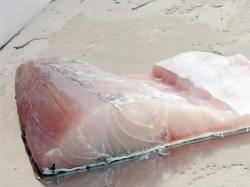Different Food Fish Can Cause Different Allergies
January 3, 2014 | 3 min to read

Leipzig – Food allergies are evidently much more specific than previously assumed. More precise tests may allow allergy sufferers more freedom of food choice in the future. This is the result of studies carried out by the Helmholtz Centre for Environmental Research (UFZ), the University of Leipzig and the Haukeland University Hospital in Bergen. The researchers examined patients with a Nile perch allergy. Being allergic to Nile perch does not mean also being allergic to cod. Furthermore, species-specific allergens were identified that may help to improve avoidance strategies against such food allergies and make them more specific, the researchers write in the scientific journal Journal of Investigational Allergology and Clinical Immunology (JIACI).
One of the subjects of the study was a chef who had developed an allergy to Nile perch (Lates niloticus) after having come into contact with the raw fish following consumption of salmon (Salmo salar)
Being allergic to Nile perch does not mean also being allergic to cod. Furthermore, species-specific allergens were identified that may help to improve avoidance strategies against such food allergies and make them more specific.
Fish is one of the most important foods worldwide. It is considered healthy, due to international fish trade it is obtainable everywhere and it is therefore consumed in increasing amounts. In the industrialised countries around 28 kilograms of fish is now consumed per capita and year, and the trend is on the increase. The rising supply and demand for seafood is associated with an increased risk of fish allergies. The most common allergen in fish and crustaceans is parvalbumin, a calcium-binding protein. Other substances, however, are also suspected triggers of allergies, such as a group of proteins in cell metabolism called aldehyde dehydrogenases. It is possible that some of these proteins have been overlooked because they are overshadowed by the more frequent parvalbumin and have therefore been underestimated until now.
The most direct way of identifying new allergens is through analysing the serum of affected patients and the proteins of the allergy source. If the IgE antibodies in the patients’ serum bind to the proteins of the food that triggers the allergy, this is a clear signal. The identified allergies can initially be used for individual diagnoses and later for epidemiological studies, to determine the relevance of individual allergies. In their study, the researchers examined two patients from the University Hospital Leipzig and ten from the Haukeland University Hospital in Bergen in Norway. One of the subjects was a 24-year-old chef from Leipzig who had developed an allergy to Nile perch (Lates niloticus) after having come into contact with the raw fish following consumption of salmon (Salmo salar). Scientists know about such cross allergies. What was unusual about this case was that the patient tolerated other types of fish. Tests indicated signs of allergies to Nile perch and salmon, but not to Atlantic cod (Gadus morhua). “The tests that are currently used are very non-specific. For some people who suffer from fish allergies there may be hope of finding a fish that they can tolerate if we managed to make the relevant tests suitable for mass implementation and use them in allergy diagnostics”, says Dr Janina Tomm from the UFZ, who specialises in research into proteins.
The researchers report a similar case in a second publication. They examined proteins of the Kuruma shrimp (Marsupenaeus japonicus); they found two new enzymes, pyruvate kinase and phosphopyruvate hydratase, that could be the cause of food allergies to shellfish. In theory, both would only have a low allergenic potential. “This shows us that even though we are significantly better at predicting allergies, computer algorithms can currently not replace biochemical experiments”, emphasises University professor Jan-Christoph Simon. Here, too, detailed knowledge about hitherto underestimated allergens could help make the correct diagnosis in cases of shellfish allergies in the future.
Publications
JM Tomm, T van Do, C Jende, JC Simon, R Treudler, M von Bergen, M Averbeck (2013): Identification of New Potential Allergens From Nile Perch (Lates niloticus) and Cod (Gadus morhua). J Investig Allergol Clin Immunol 2013; Vol. 23(3): 159-167.
http://www.jiaci.org/issues/vol23issue3/4.pdf
JM Tomm, C Krause, JC Simon, R Treudler, M von Bergen, M Averbeck (2013): Pyruvate Kinase and Phosphopyruvate Hydratase as Novel IgE Reactive Proteins in Prawn. J Investig Allergol Clin Immunol 2013; Vol. 23(6): 000-000
The studies were supported by the Leipzig Research Center for Civilization Diseases (LIFE) and funded by the European Union, the European Social Fund and the excellence initiative of the Free State of Saxony.
Source: Helmholtz Centre For Environmental Research
